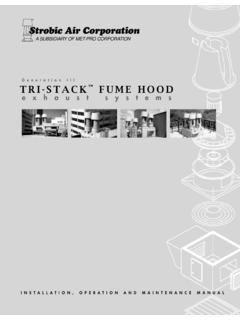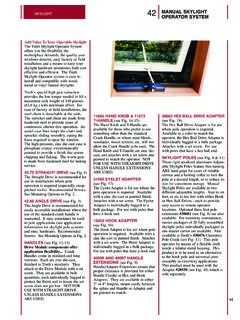Transcription of Managing Emergency DieselManaging Emergency ...
1 Managing Emergency DieselGenerator ExhaustManaging Emergency DieselGenerator ExhaustTri-Stack systems at BrickHospital prevent emergencydiesel generator exhaust re-entrainment and eliminateneighborhood odorsASKTHEE xpertsDIESELGENERATOR EXHAUSTM anaging Emergency DieselGenerator Exhaust for Re-entrainment Prevention, AirPollution Abatement, andOdor ControlA good neighbor policybenefits everyoneBy: Paul A. Tetley, Vice President &General Manager, Strobic Air Corp.,a subsidiary of Met-Pro Corp.,Harleysville, PAIndustry experts answer your facility compliance diesel generatorsare necessary evils at all hos-pitals. No one likes to have themaround, but they must be avail-able to provide immediate back-up electrical power in case ofsudden power generators mustalsomeet critical performancerequirements,but they can alsocreate problems when tested(generally weekly without loadand monthly under load).
2 The two major problemscaused by diesel generatorsinclude possibilities of re-entrain-ing their exhaust into the hospi-tal s ventilation system (or anadjacent building s), and unpleas-ant diesel exhaust odors in theneighborhood. To prevent theseproblems at the Meridian HealthSystem for Brick Hospital inBrick Township, NJ Bill Transue,facilities manager for the hospitalsought a unique Brick Hospital consists ofthree linked buildings, totaling340,000 The original build-ing (South Wing at 125, ) opened in 1984; the WestWing 154,000 wasadded in 1993; and an additional16,000 sixth story wasadded in 2000 to accommodate32 medical/surgical unit in 2000 the ambulatory carebuilding was completed. This is atwo-story addition with an inter-connecting atrium to the SouthWing which contains 44, The hospital includes med-ical/surgical units, operatingrooms, an expanded emergencydepartment, radiology, physicalEtherapy, a laboratory, pharmacy,maternity suite, same day med-ical, cardiology and neurologydepartments, all serving a grow-ing re-entrainment andodor controlExhaust re-entrainment andodor control at hospitals havebecome sensitive issues over thepast few years.
3 Often, employeecomplaints have culminated inlawsuits for damages claiming ill-nesses caused by re-entrainedexhaust air from rooftop recently, the mostcommon method for handlingdiesel generator exhaust wasthrough dedicated centrifugal-type fans with tall exhaust stackson the building s roof . For themost part this technology did noteliminate re-entrainment or odorproblems, since the exhauststream was subject to a variety of atmospheric upon wind speedand/or direction, diesel exhaust and associated odors wentright back into the hospital or toan adjacent said that when theWest Wing was completed in 1993,the Emergency generator exhaustwas being re-entrained into thefresh air intake ventilation systemof the building.
4 In an attempt tocorrect the problem, new duct-ing was constructed leading tothe roof of the existing SouthWing. Even this didn t solve ourproblem all the time, Transueadded, since during some weath-er conditions the air could notproperly absorb or dissipate theexhaust. As a result, it was alsore-entrained into the SouthWing s ventilation air intakes. Asa matter of fact, when it was relo-Mixed flow impeller fans can prevent diesel generatorexhaust and odor from re-entering hospital May/June 2001cated, it actually created more ofa problem than if it had been leftwhere it was, Transue said. Wewere living withthat problem forabout seven years. Exhaust dilution and disbursementIn addition, centrifugal fans which are belt driven are main-tenance-intensive, and the sightof tall exhaust stacks on the roofhad negative implications withregard to people in the neigh-borhood.
5 As a practical alterna-tive, use of mixed flow impellersystems that send a vertical jetplume of exhaust well above theroofline has become popular forthis application. The jet plumedisburses exhaust pollutants and odors high enough intothe atmosphere to both meetapplicable pollution abatementlaws and eliminate odor. Thesesystems work by mixing outside,ambient air with the exhaustgases to effectively dilute theexhaust stream thus preventingre-entrainment into the building sintake air ventilation system,doors, and windows. Exhaust re-entrainment is also preventedfrom entering adjacent buildingswith this are two diesel-poweredgenerators at Brick Hospital, oneof which is rated at 900 kW (theWest Wing) and one at 635kWfor the South Wing.
6 To eliminatethe re-entrainment problem,Transue contacted Steven J. DiFlora, at Kallen & Lemelson, con-sulting engineers in New YorkCity. DiFlora and his associatesrecommended that mixed flowimpeller fans be mounted on theroof to serve the two fans are rated at 20 hp and15 hp respectively, with the 20hp fan operating at about 7600 CFM with flue gases at 840 Fwhich mixed with the ambientair at a 560% dilution ratio, effec-tively providing about 43,000 CFM total at 186 F. Even with a10 MPH crosswind, the exhauststream is projected at a nozzlevelocity of over 4,600 FPM risingto a height of approximately 65'above the roofline, thus enablingeffective dissipation and prevent-ing possibilities for flow technologyoffers an efficient solutionDiesel engines are especiallysensitive to changes in exhaustsystem back pressure, andDiFlora recommended mixedflow impeller fans because theyhave no effect on engine perfor-mance yet inherently pressurizeengine exhaust gases for moreefficient discharge.
7 Mixed flowimpeller fans incorporate anintegral mixing plenum (seeillustration at right) that dilutesthe exhaust stream as much as170% with ambient high efficiency when combined with the mixingplenums below the roofline resulted in the extraordinarilyhigh 560% dilution ratioachieved. Dampers on the sys-tem also eliminate upstreampressure effects on the dieselengines, therefore preventingbackpressure problems thatwould ordinarily reduce genera-tor power configuring this system,Kallen & Lemelson terminatedthe existing flue pipes on theroofs of the South and WestWings,intercepting them and forming new transition sec-tions to connect to the fans. Aminimal amount of reinforcingsteel was added to the building sroof framing structure.
8 Each fanwas bolted to its curb, and eachcurb was bolted through theroof to the supplementary sup-port steel. Because the fans areprecisely balanced and usedirect drive motors, there was noneed for additional vibration iso-lation. Transue said, The fansoperated smoothly with no sen-sation of vibration below in theoccupied spaces. And from anaesthetic standpoint, these fansare barely noticeable from thesurrounding totheir capabilities, there was noneed for any tall flues or stacks, he A. TetleyStrobic air flow impeller-type roof exhaust systems operate on a unique principle ofdiluting outside air with plenum exhaust air at high discharge velocities, send-ing a powerful vertical exhaust plume up to 350' they introduce up to 170% of free outside air into the exhaust stream,a substantially greater airflow is possible for a given amount of exhaust withoutadditional horsepower, providing excellent dilution capabilities and greatereffective stack heights over conventional centrifugal systems also reduce noise, use less energy, and provide enhanced per-formance with faster payback over conventional centrifugal laboratory fumehood exhaust systems, with typical energy reduction of $.
9 44 per cfm at$.10/kilowatt-hour, thus providing an approximate two year Energy con-sumption is about 25% lower than with conventional centrifugal fans, with sub-stantially reduced noise levels, particularly in the lower octave bands. Theyconform to all applicable laboratory ventilation standards of ANSI/AIHI aswell as ASHRAE 110 and NFPA 45, and are listed with Underwriters Laboratoryunder UL systems are designed to operate continuously without maintenance foryears under normal conditions; direct drive motors have lifetimes of 200,000-hours. Non-stall characteristics of the system s mixed flow wheels permit vari-able frequency drives to be used for added variable air volume (VAV) savings,built-in redundancy, and design maintenance free operation (there are no belts, elbows, flex connec-tors, or spring vibration isolators to maintain) eliminate the need for expensivepenthouses to protect maintenance personnel under adverse , additional savings of several hundreds of thousands of dollarsare realized in a typical flow impeller systems are available with a variety of accessories thatadd value, reduce noise, or lower energy costs substantially.
10 For example,accessory heat exchanger glycol/water filled coils for use in 100% conditionedmakeup air facilities add exhaust heat to intake ventilation air to save thou-sands (or hundreds of thousands) of dollars in energy flow technology offers many performanceand cost May/June 2001 Tall stacks are good,butTr i -Sta c ks are best! low profile , quiet solutions for roof exhaust problems forlaboratory workstationsandindustrial processingPrevent re-entrainmentEliminate odorReduce noise at the property lineComply with architectural/aesthetic ordinancesLower energy costsFor design/applications tips, visit our web site: E-mail: pollution abatement andodor control(quietly)..Tri-Stack systems are ideal for new construction and directreplacement of conventional centrifugal exhaust fans.




![Index [www.fandept.com]](/cache/preview/8/2/1/7/a/e/c/d/thumb-8217aecd553b7e6a7bea5aba32403881.jpg)



